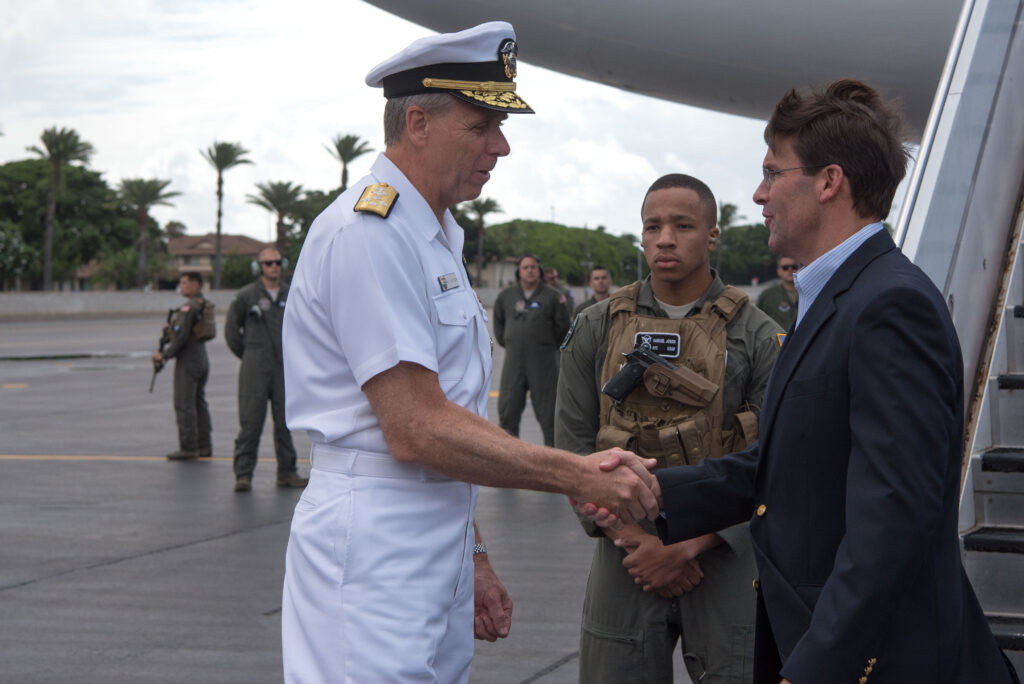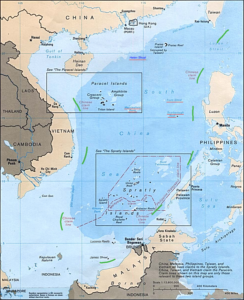
Defense Secretary Mark Esper is greeted by Indo-Pacific Commander, Adm. Philip Davidson in Hawaii.
WASHINGTON: Defense Secretary Mark Esper walked a delicate line today, seeking to balance President Trump’s desire to withdraw US forces overseas, a strong commitment to allies like South Korea and Taiwan, and an offer to visit China even as the US ramps up Freedom of Navigation patrols in the disputed waters of the South China Sea.
Esper said he hasn’t ordered any reduction in the number of US troops in South Korea — at least, not yet — despite reports that the Pentagon has presented options to the White House to do so. But he is considering a new rotational model for overseas deployments.
“I’ve issued no orders to withdraw from the Republic of Korea,” Esper said during a question and answer session hosted by the London-based IISS on Tuesday. “We will continue to look at adjustments at every command we have in every theater,” he added, including rotational deployments.
Since 2018, Washington and Seoul have engaged in a series of tough negotiations to meet President Trump’s demands that South Korea pay more to house 28,500 US troops in the country. The two sides managed to hack out a one-year extension calling for South Korea to pay $926 million, or an 8 percent increase, far less than the $5 billion the White House had initially sought.
Pentagon spokesman Jonathan Hoffman confirmed that Esper is considering moving to a more rotational presence, telling reporters at the Pentagon, “the secretary’s goal is to remove some of the footprint of having forces forward deployed.” Hoffman didn’t make any announcements in that regard, but said rotations would give the US “flexibility” in training with allies.
Esper’s suggestion of using rotational troops might be a way to find a middle ground between Trump’s years-long demand to drastically reduce US troops presence overseas and the Pentagon’s desire to maintain large bases across Europe and the Pacific.
The Pentagon plans to pull 9,500 troops out of Germany, bringing the force level there from 34,500 to 25,000. So far, however, military officials haven’t announced which units would leave, and where they would go. Poland and Latvia — two countries in Trump’s good graces since they met the NATO goal of spending two percent of their GDP on defense — have already jumped at the chance to house those troops, though no decisions have been made.
As tensions between Washington and Beijing continue to spike in the South China Sea, Esper said Tuesday he’s looking to visit China this year “enhance cooperation on areas of common interest, establish…and reinforce our intentions to openly compete in the international system.”

The “nine-dash line” describing Chinese claims to the South China Sea
It was a rare olive branch in a war of words between the two countries over Chinese claims to islands and small outcroppings in the South China Sea, and the US-led effort to push back against those extra-legal claims.
In 2019, the Navy conducted a record number of ‘freedom of navigation operations’ (FONOPS) in the critical waterway to challenge Chinese land grabs, something Esper said will continue through this year.
Showing the US commitment to Taiwan is a key element of those FONOPS. The administration “remains committed” to Taiwan, even as China is becoming more assertive, Esper said. “They’ve got hundreds, if not over a thousand, missiles aimed at Taiwan. And we’ve seen President [Xi Jinping] and his party really take this to a new level,” he said.
“China is aggravating the situation,” he continued. “I don’t think anybody in Taiwan believes at this point that China has any intention whatsoever of living up to its one country, two systems.”
Over the past two weeks, the US has run major dual-carrier exercises in the South China Sea, after which the two American strike groups, led by the USS Ronald Reagan and USS Nimitz, sailed in different directions to drill with major allies in the region. USS Ronald Reagan moved east to the Philippine Sea to run trilateral exercises with the Japanese and Australian navies, while USS Nimitz headed west through the Indian Ocean to work with the Indian navy.
The partner operations no doubt send a clear signal to Beijing that Washington is working hard to build interoperability and trust with allied navies as the Chinese navy continues to push new warships to sea at a breakneck pace.






















